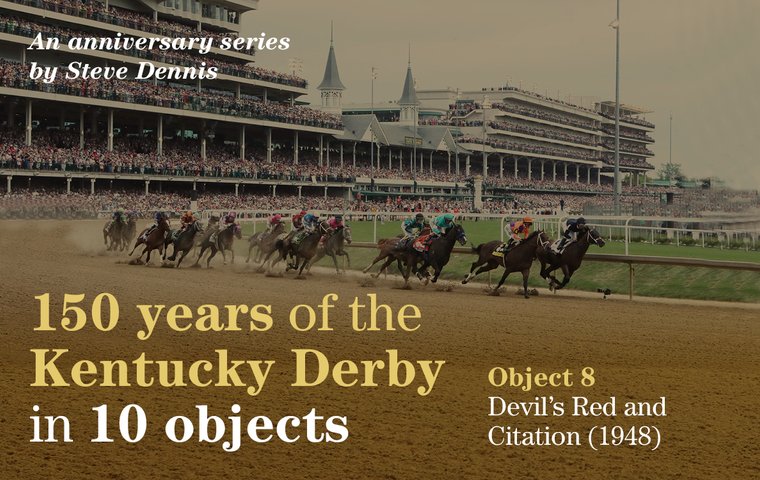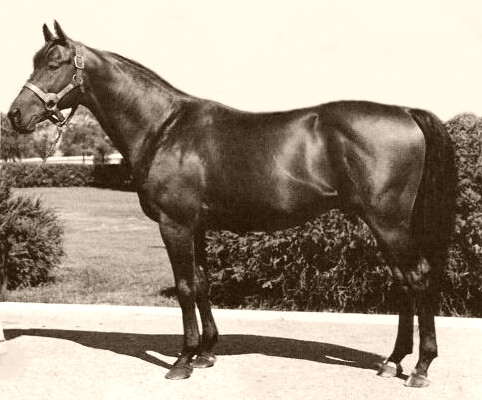
In the latest instalment of his popular series, Steve Dennis remembers the glory days of the famous devil’s red silks as they dominated the Kentucky Derby scene
The colours worn by jockeys are more integral to the spirit of racing, the very life of racing, than purely a means of identification.
 Certain sets of silks become indivisible from the horses who carried them, evoking images that remain vivid even as those rainbow jackets fade. The bold, bright ‘devil’s red’ colours of Calumet Farm no longer feature in the Kentucky Derby, but there was a time when they dominated the race.
Certain sets of silks become indivisible from the horses who carried them, evoking images that remain vivid even as those rainbow jackets fade. The bold, bright ‘devil’s red’ colours of Calumet Farm no longer feature in the Kentucky Derby, but there was a time when they dominated the race.
Those famous battle colours – adorned by two blue hoops on each sleeve, a blue collar and a blue cap – flew over Churchill Downs seven times during the 1940s and 1950s, the Calumet years when the farm on Versailles Road in Lexington became the centre of the sport in the US.
The business was established by baking powder tycoon William Wright in 1924, but the empire-building only began in earnest in 1939, when Ben Jones and his son Horace ‘Jimmy’ Jones were employed as Calumet’s trainers.
The resolutely old-school ‘Plain’ Ben Jones had won the 1938 Derby with Lawrin, and quickly brought his ineffable, instinctive talent to bear on Calumet’s blue-blooded stock. The first Derby came in 1941 with the outstanding Triple Crown hero Whirlaway, and three years later Pensive brought home the Roses. The best was yet to come.
All-time great
Citation was a phenomenon, a colt whose achievements ensured his status as an all-time great, this son of the prep otent Bull Lea who would give Calumet another Triple Crown, win 16 races straight, and become the first horse in history to earn more than a million dollars in purses.
otent Bull Lea who would give Calumet another Triple Crown, win 16 races straight, and become the first horse in history to earn more than a million dollars in purses.
Citation went eight-for-nine as the champion two-year-old of 1947, and won six of his seven races in the build-up to the Derby, including the Derby Trial four days before the real thing.
On the way to Churchill Downs, the personnel had changed. Citation’s regular rider Albert Snider drowned while fishing off the Florida Keys in March, and Jimmy Jones – who had assumed day-to-day duties at Calumet that year after Ben had taken on a more management-oriented role – temporarily stepped aside in order to let his old man take a shot at equalling the record of four Derby wins held by Herbert ‘Derby Dick’ Thompson.
Citation’s new jockey Eddie Arcaro was also eyeing the record books; no rider had ever won four Derbys, and ‘Banana Nose’ had three in the bank already. Arcaro prepared for his bid for immortality by getting arrested on Derby eve, giving a traffic cop too much lip – ‘words between them’ ran the prim account in the New York Times – before making bail for $25.
 That wasn’t the only cloud in Arcaro’s sky. Citation had already convinced the world of his brilliance and he only had five horses to beat in the smallest field since 1907, but one of them was his barnmate Coaltown, who had shown scintillating speed in winning all his four starts including the Blue Grass at Keeneland. Arcaro was on edge.
That wasn’t the only cloud in Arcaro’s sky. Citation had already convinced the world of his brilliance and he only had five horses to beat in the smallest field since 1907, but one of them was his barnmate Coaltown, who had shown scintillating speed in winning all his four starts including the Blue Grass at Keeneland. Arcaro was on edge.
“Which is the better horse?” he asked Ben Jones.
“If I thought Coaltown could win this Derby, Eddie, you’d be on him,” came the reassuring answer.
Irreducible confidence
Jones’s confidence in Citation’s ability was irreducible. “I think Citation will win because, in my opinion, he can catch and beat any horse he can see – and there is nothing wrong with his eyesight,” he told the press pack in Runyonesque style.
Such was the overwhelming prowess of the Calumet pair that they were coupled at 2-5 on the tote board, with no place and show betting permitted.
It was a notably chilly day in Louisville but Coaltown turned up the heat from the start, breaking on top under Newbold Pierson – who wore a distinguishing Devil’s red cap – and stretching out a six-length advantage halfway down the backstretch. If he was worried before, Arcaro was scared stiff now.
 “I was saying to myself ‘what the hell is going on here?’,” he confessed afterwards. Jones was right, though; Citation could see Coaltown, he closed him down and caught him around the turn, and then surged effortlessly, exhilaratingly away to beat him hollow.
“I was saying to myself ‘what the hell is going on here?’,” he confessed afterwards. Jones was right, though; Citation could see Coaltown, he closed him down and caught him around the turn, and then surged effortlessly, exhilaratingly away to beat him hollow.
There were no traffic issues now for the relieved Arcaro, who hand-rode Citation 3½ lengths clear, the colt’s ears jauntily pricked as he crossed the line. “He’s a great horse,” said the jockey, who gave the widowed Mrs Snider a share of his prize-money. “He’ll win the Triple Crown.”
And he did, with Jimmy Jones restored as trainer of record.
More glories on the horizon
That was the high point for the devil’s red silks, but there were more Derby glories on the horizon. Ponder (1949) and Hill Gail (1952) won with Ben Jones back on the licence, and Jimmy got official recognition when Iron Liege (1957) and Tim Tam (1958) took Calumet’s tally to seven in 18 years.
There would be one more, Forward Pass belatedly getting the 1968 renewal on the disqualification of Dancer’s Image, trained by Henry Forrest (Jones snr died in 1961; Jones jnr retired in 1964).
 The last truly great horse to carry the Devil’s red was Alydar, the virtuoso second fiddle to Affirmed during the 1978 Triple Crown series, who in any other year would have swept the board with a flourish. Subsequently, the Calumet empire began to fall, gradually at first and then suddenly, dramatically, shockingly.
The last truly great horse to carry the Devil’s red was Alydar, the virtuoso second fiddle to Affirmed during the 1978 Triple Crown series, who in any other year would have swept the board with a flourish. Subsequently, the Calumet empire began to fall, gradually at first and then suddenly, dramatically, shockingly.
Reckless slide into colossal debt
Calumet disintegrated under the leadership of J.T. Lundy, who oversaw a reckless slide into colossal debt serviced almost exclusively by Alydar’s immense success as a stallion. After Alydar died in mysterious and allegedly malign circumstances in November 1990, Calumet filed for bankruptcy and, at the auction of the farm’s remaining assets, ownership of the iconic Devil’s red silks was purchased for $12,000 by Brazilian owner-breeder Goncalo Torrealba.
But Calumet Farm – aptly, for a business built on baking powder – rose again. It is now owned by Brad Kelley, and the farm’s horses run in Kelley’s black-and-gold silks.
The days of the Devil’s red have gone forever, but the exploits of Citation, Whirlaway, Tim Tam and their fellows remain resolutely rose-hued in the memory.
• Visit the Kentucky Derby website and the Kentucky Derby Museum website
‘He had materialised as if from nowhere’ – reliving the unlikely tale of Canonero II
‘The 2008 Kentucky Derby would shake racing’s complacency about its bad old habits until it cracked’
View the latest TRC Global Rankings for horses / jockeys / trainers / sires


